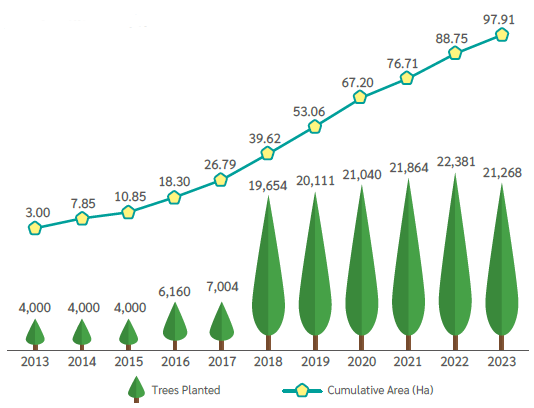
Social Involvement
Conserving the Environment
Climate change is an issue that humanity must face. Saving energy and reducing carbon emissions are the starting points for Conserving the Environment. For years, USI has been cooperating with Shanghai Roots & Shoots in the Million Tree Project to purify air quality and restore biodiversity. Also, we participate in the Campus LED Installation Project to replace LED lighting for rural schools to save energy and schoolchildren's eyesight. We host activities such as Environmental Seminars, Mini Farmers' Markets, and Environmental Cleanups to promote green and low-carbon lifestyles, raise environmental awareness, deepen connections with neighboring communities, mitigate negative impacts, and contribute to the global environment.
Million Tree Project
USI joined the Shanghai Roots and Shoots' Million Tree Project since 2013. In addition to reversing land degradation and desertification in Inner Mongolia and Ningxia, planting trees also restores local biodiversity. The latest ecological survey reports 47 species observed in Inner Mongolia and 14 species in Ningxia, indicating the sand has begun stabilizing, the ecosystem is reaching a balance, and there are early signs of recovery.


By the end of 2023, USI has planted 151,482 trees covering 97.91 hectares and cumulatively captured 729.44 metric tonnes of CO2e using IPCC Guidelines. The afforested land conserves about 134,332.52 metric tonnes of water annually through water balance estimation methods.
USI Tree Planting Data

Campus LED Project

Since 2014, USI has assisted the ASE Environmental Protection and Sustainability Foundation in launching the Campus LED Installation Project in remote elementary and middle schools in Nantou to enhance energy conversion and lighting in rural schools. In 2023, we assisted in the installation of 2,723 LED lights for 595 teachers and students in Nantou's Wenshan, Xiling, and Zhanghe Elementary Schools, saving 58,817 kWh of power and thus reducing 29,114 kg of CO2. In total, we have installed 42,294 lights in 46 schools, creating low-carbon and sustainable campuses.


